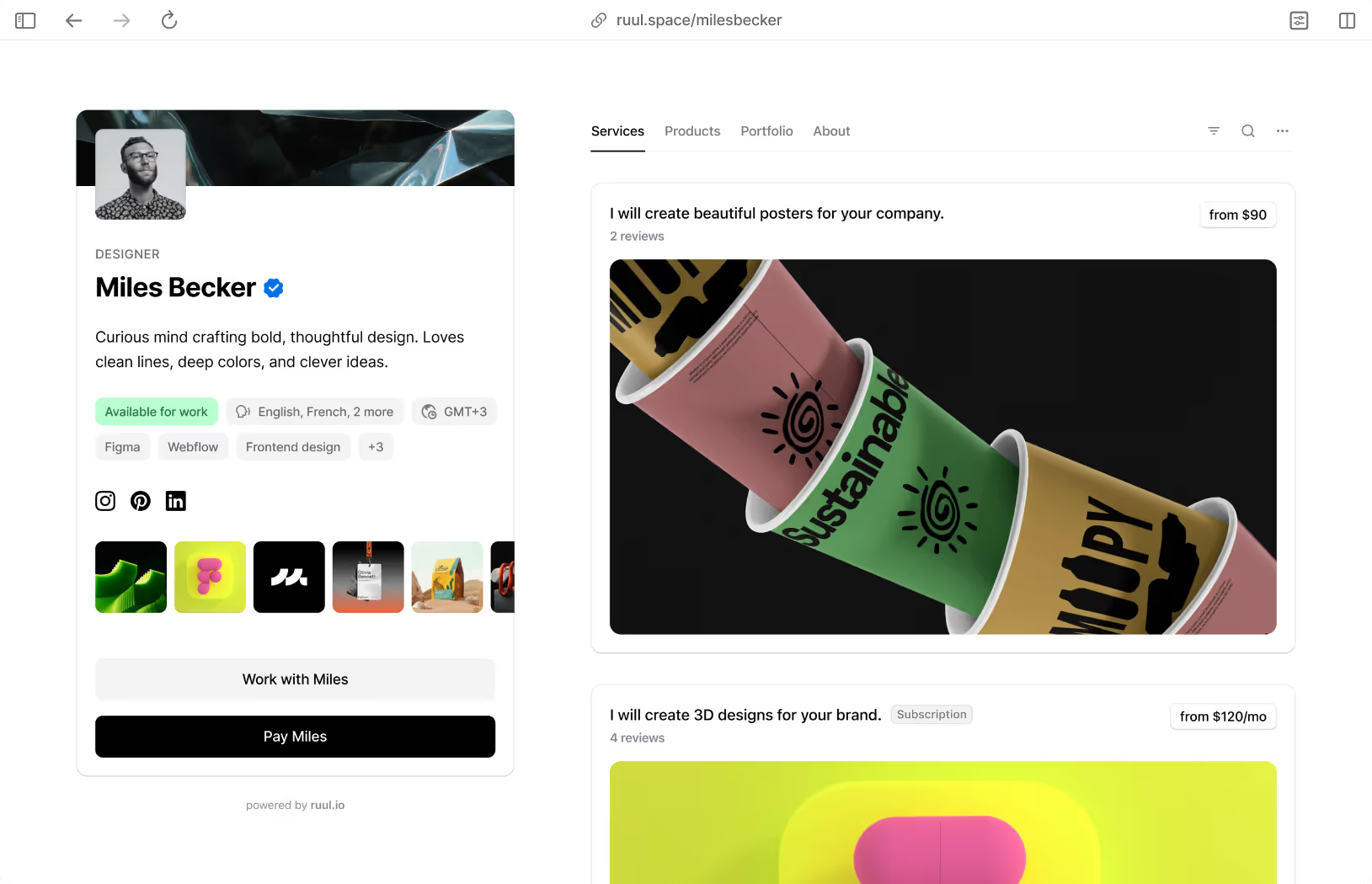Dribbble is an online platform where designers can share their work, look for inspiration, and find work.
It’s designed for creative professionals because of the platform's visual nature.
Think UI, UX designers, artists, graphic illustrators, animators, product and web designers, brand creators, motion designers, and creative directors.
It’s ideal to
- Share your portfolio of creative work
- Engage with designers
- Find clients, businesses, or developers
- Increase your online presence
Strengths and weaknesses for freelance designers
Let’s see both faces of Dribbble.
Strengths (The "Pros") of Dribbble
1. A high-quality Dribbble portfolio can bring big opportunities.
Dribbble is a virtual gallery to showcase your finished, polished work.
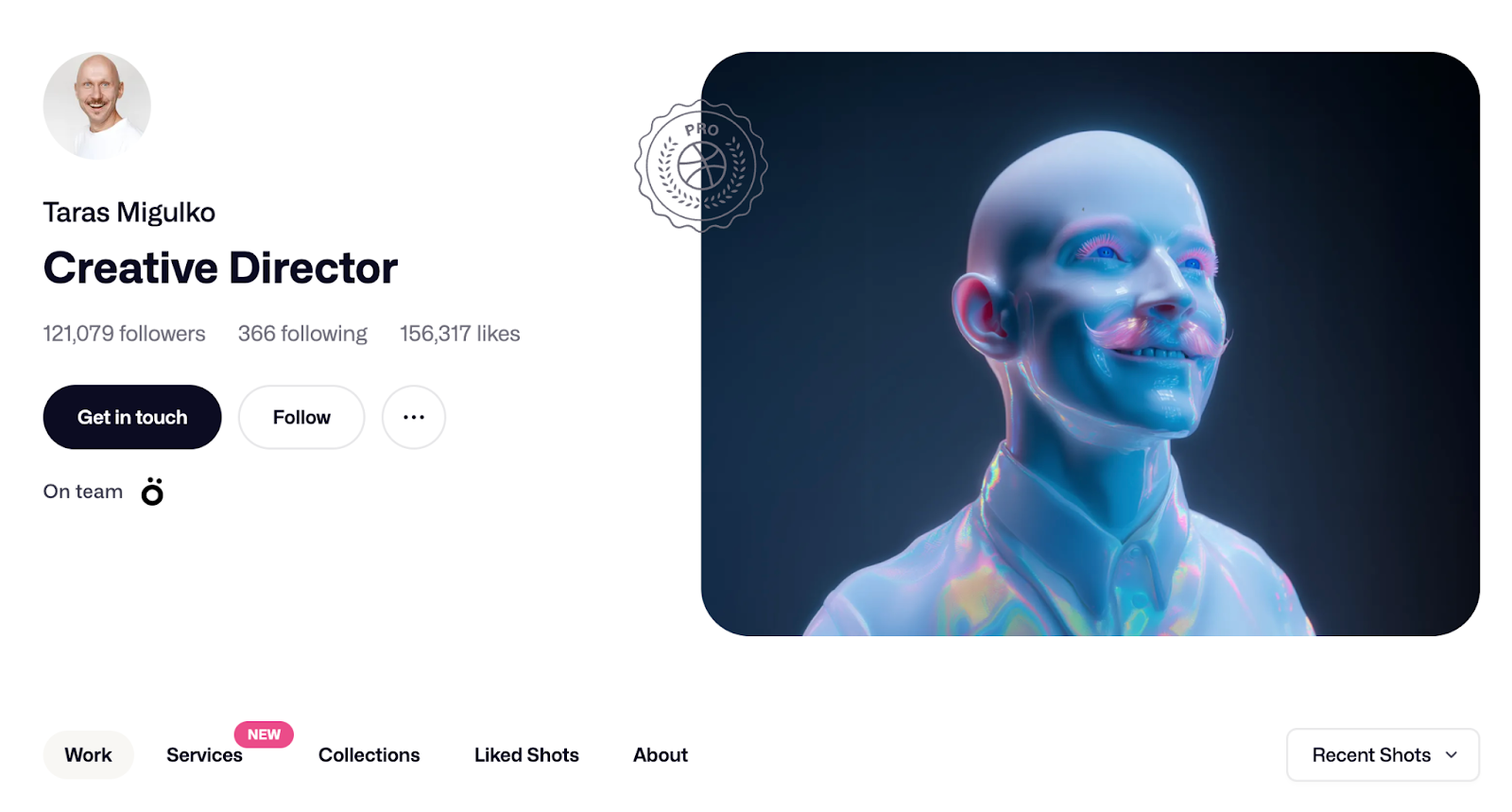
- your works,
- your services,
- your collections (like 3D, web, icon), and
- your about section together.
A simple portfolio setup can outperform a bland résumé, particularly for a professional who's visually focused like in UI/UX design, product design, or graphic design.
Each Shot in your Dribbble portfolio can tell a story. And a good story can lead the client to click the “Get in touch” button.
2. Dribbble interactions can lead to new and great connections
The Dribbble community offers an interactive way to grow your creative network.

Much like on Instagram, you can:
- follow other designers' accounts
- like their shots
- comment on other designers' work
- even send direct messages
This encourages building new friendships and collaborations on Dribbble, not just finding clients.
3. Dribbble’s “Discover” can spark creative inspiration
Dribbble is also for spotting design trends and aesthetics.
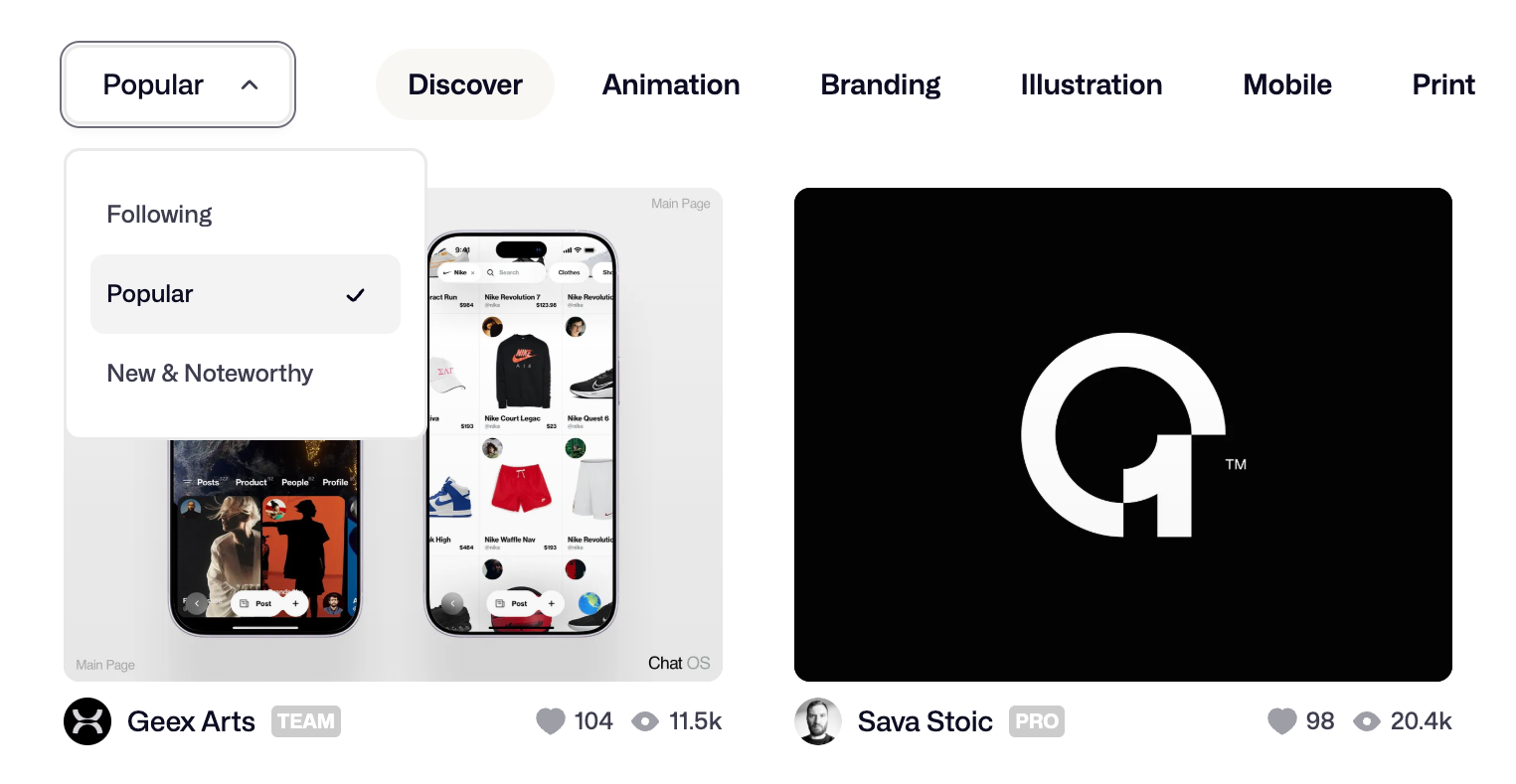
To be honest, inspiration does not always strike you naturally. Waiting on inspiration isn't the most effective strategy for stimulating creativity 🙂
As a designer, Dribbble (and other sources of inspiration) can be a valuable resource.
Limitations (The "Cons") of Dribbble
1. The "Dribbblisation" Effect
The biggest risk I see 👉🏻 The Dribbblisation Effect
Here’s what I mean:
Focusing on purely visual outlets can lead you to design things that look beautiful and then fail miserably with real clients or complex UX problems.
No lie. People often fall for polished visuals instead of thoughtful design processes. I used to fall for that, too, because the search for aesthetics is always at the forefront for designers. But that focus can push true usability into the background.
When you add pressure to get likes and compete, Dribbble can easily turn into a cluttered mess. 😬
To protect yourself from the Dribbblisation Effect, share the story behind your design (its origin, purpose, process, and user flow diagrams) under your Shots.
2. Competition and shallow comments can lead to invisibility
The talent pool is huge. Getting noticed can feel like shouting in a stadium.
To prevent Dribbble from becoming similar to the "dead internet" theory, designers must make some changes.
Dribbble has roughly 16 million users, and Contra has around 300,000 users.
For a complete comparison: Dribbble vs. Contra vs. Behance
The crowd on Dribbble often falls into “superficial feedback” behavior. 👇🏻

Designers leave shallow, bot-like comments such as “great job” or “amazing work” on others’ Shots. Their goal is to give and get engagement, but it slowly kills the platform.
You can break this cycle on your own profile. Instead of writing “great,” leave thoughtful, high-quality feedback and critiques.
That way, you’ll stand out, and other designers might start giving you the same kind of valuable feedback in return.
3. Dribbble pushes you to go Pro for many features
Dribbble constantly nudges you toward the “Pro” plan, which can both limit you and pressure you to pay.
Some paid features include:
- Avoiding the commission: 0% for Pro users (normally 3.5%)
- More visibility: Free users usually stay in the background.
- Custom portfolio & domain linking: You need Pro to personalize it.
- Ad-free experience: Free accounts still see ads.
- InstantMatch: Instant client matching is only for Pro users.
From what I’ve seen, users really dislike this.
I came across a comment that said:
— “Dribbble... has now become a bloated commission system built just to exploit us designers.” [Reddit]
4. Dribbble puts you in charge of managing money
Here is the weakest part of Dribbble. This confuses many freelancers. Now I will give you a concise and brief overview of what Dribbble does and does not provide (where it just leaves you alone).
Invoicing (Lack of Automation)
Dribbble creates a simple invoice for each project (project name + total amount). However, it cannot calculate regional taxes, add special payment instructions, or send automatic payment reminders.
🤝🏻 Ruul issues a legal payout invoice to the customer on behalf of Ruul and to you. The invoicing process is 100% legal and internationally valid.

Compliance (Lack of Tax and International Management)
Dribbble doesn’t handle any tax management; all responsibilities fall on the user.
🤝🏻 Ruul's Merchant of Record model ensures a compliant revenue stream by legally documenting each transaction. It manages complex taxes such as VAT and WHT within its own system.
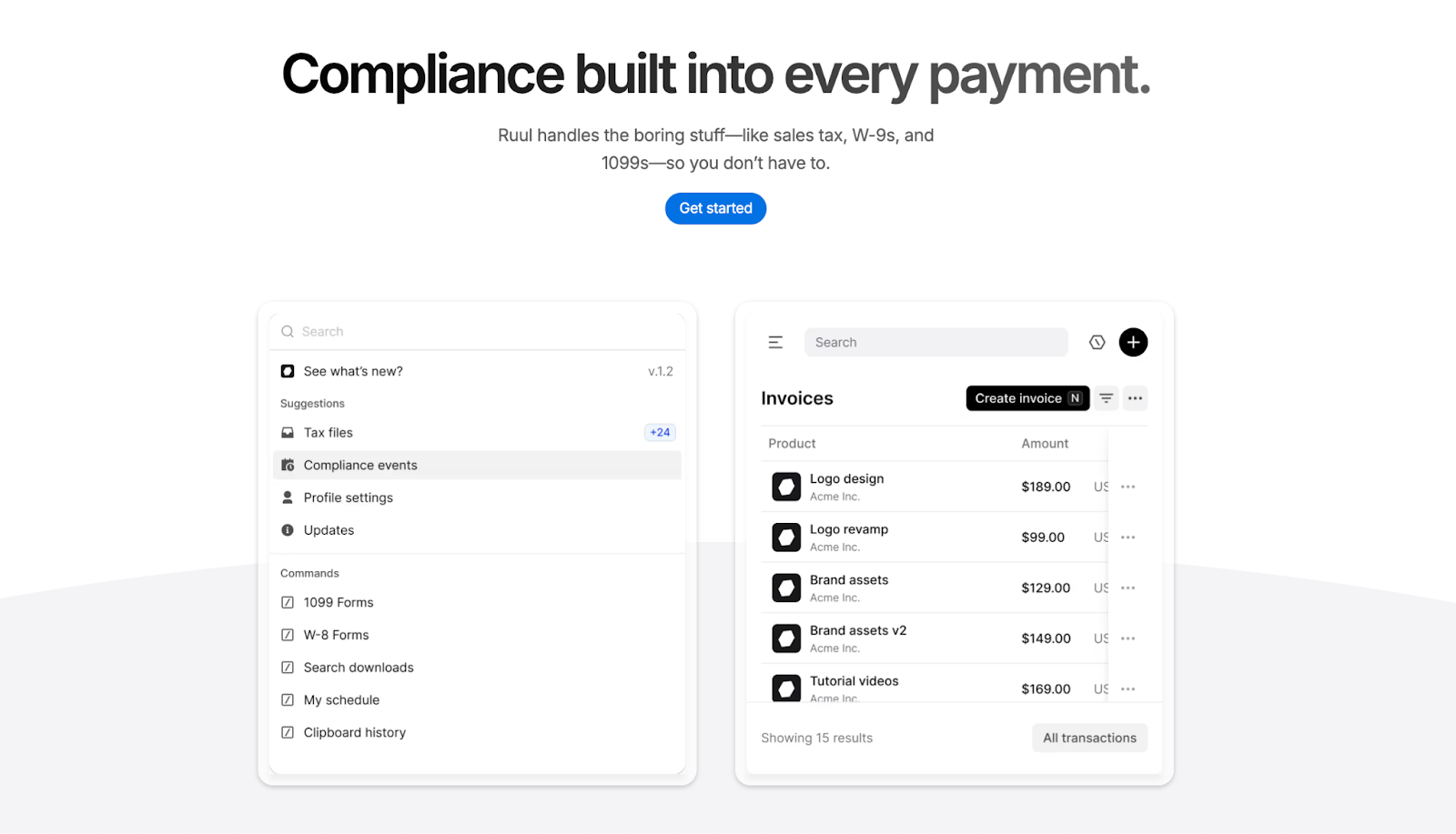
The Designer’s Burden
If you are a designer in Berlin working for a client in New York, you need a financial system that can properly document payments for both German tax authorities and your US client.
Otherwise, you may face troublesome tax audits.
This is why external platforms are crucial.
These platforms ensure compliance with all international financial regulations by
- securing payment collection,
- creating contracts, and
- handling compliance procedures.
Want to simplify international compliance? 👉🏻 Explore Ruul Space for seamless global payments and documentation!
Building a successful presence on Dribbble
1. Optimize your content
Every shot should be high-quality and clear, because quality always wins.
You can add to your shots:
a) Visual (your first impression weapon)
What people see about your work in Discover looks exactly like this:
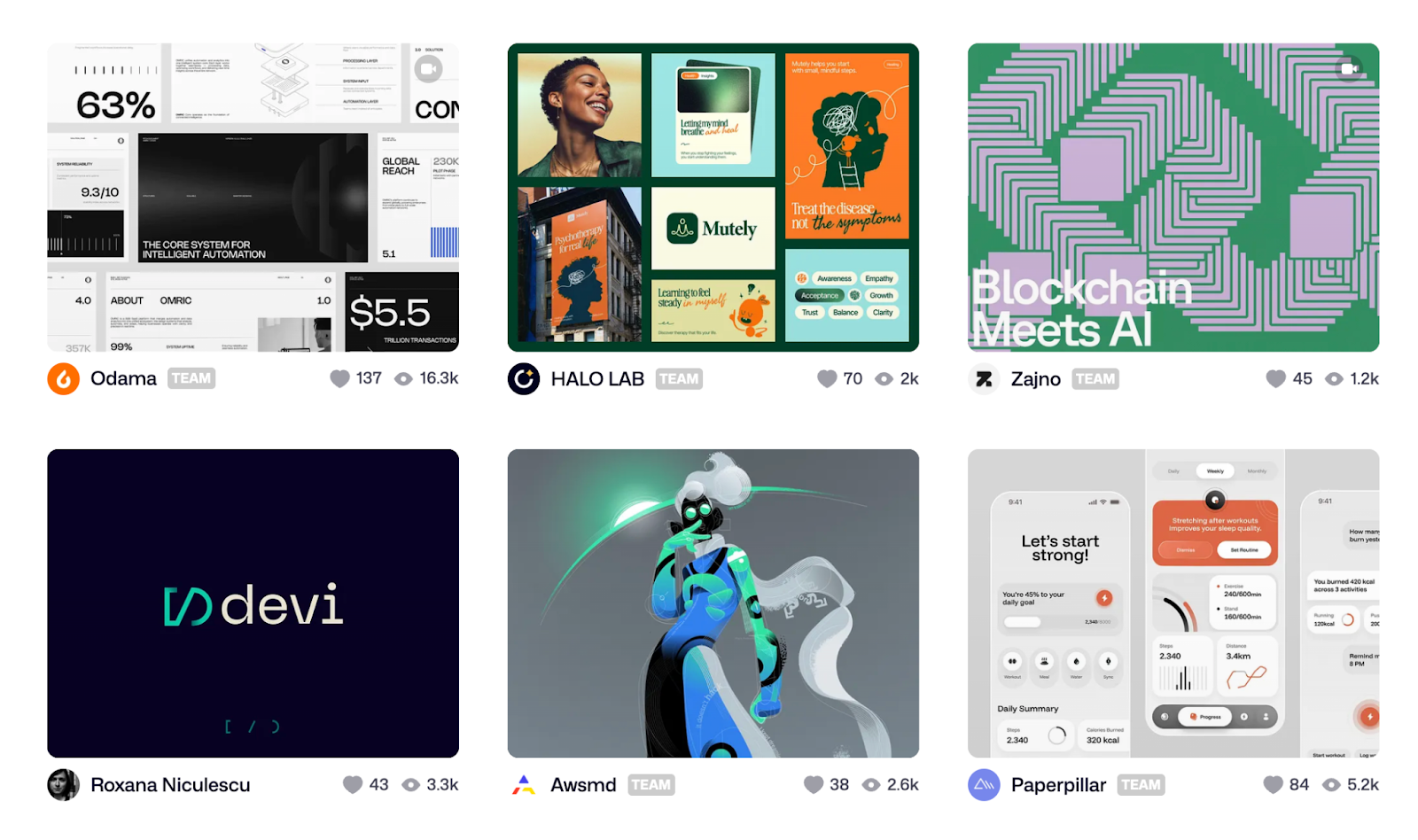
Yes, there’s not even a title (just the visual) and I don’t need to explain how important that is.
- Thumbnail effect: On the Explore page, the first thing that catches the eye is the image. Strong compositions and color can seriously boost your click-through rate.
- Quality presentation = professionalism: Work shown with mockups or in a clean grid layout looks “agency-level” (like the example above).
- Trend awareness: Showing current styles like minimal, gradient, or skeuomorphic design makes your profile look up to date.
🔑 My advice: The combo of “2D UI + animated GIF + zoomed-in detail” works great.
b) Video (Your way to tell the story)
Dribbble highlights animated content over static visuals.
- Longer view time: When people watch a video, they stay on your page longer → the algorithm sees this as “interest.”
- Chance to show user experience: For UI/UX designers especially, showing flows, transitions, and hover effects proves your design’s usability.
- Inspiration + educational value: Videos that share interactive details get more saves and shares.
🔑 My advice: Short 3–6-second loops (like loading animations or microinteractions) perform best.
c) Text (The strategy under your visual)
Every Dribbble Shot should tell a story through words.

Use the space under your Shot to freely share your project’s story (there’s no word limit).
In another blog post, we explained why storytelling will be one of the top freelance skills in 2025. [Top Freelance Skills] Platforms like Dribbble are great places to practice it.
A good story
- Explains project context: Target users, the problem you solved, tools used, process, and more.
- Creates SEO impact: Dribbble descriptions are indexed by Google. Shots with detailed captions appear more in searches.
- Builds professional trust: For clients or recruiters, it says, “This designer doesn’t just create, they think.”
- Starts conversation: Sharing your process in the description section encourages community interaction.
🔑 Structure your text using the “Design goal → Process → Outcome” format
1. Goal: Improve onboarding clarity
2. Process: Tested 3 layout variants
3. Outcome: +28% signups in usability tests
2. Optimize your profile
a) Add a professional photo or a high-quality logo that reflects your personal brand.

b) In the About section, briefly explain who you are and what your goal is.

c) List your skills: include keywords like “UI/UX,” “branding,” or “remote work.”

Since Dribbble works like a search engine, this will help you get found more easily.
d) Prepare all your design services with full details, ready to sell.

That way, clients won’t wonder, “Does this person offer what I need?”
If they’re convinced, they can hire you instantly after clicking on your service. 👇🏻

As you can see, adding details about your service (like the concept, duration, and number of revisions) will help you avoid misunderstandings.
“Services” is a new feature. To learn how it works:
👉🏻 What Dribbble’s New Services Feature Means for Creative Freelancers?
3. Share shots routinely
Post regularly to stay visible to both the algorithm and potential clients.
It’s better to share one high-quality post every 10 days than four random ones a month. Publish something that’s a complete piece of art (visuals, text, and all the details). A success story:
A designer who followed a “regular posting + niche focus” strategy
- Grew from 450 followers to over 500 in just 13 days, and
- In 3 months, they reached their goal of 5,000+ followers.
4. Engage with the community
Be an active member of the community. Like, comment, connect.
But as I said, being thoughtful matters. A few short words can make you look like a bot.
Here’s an example of a short but meaningful comment:
— “The color gradients and typography harmony are perfect! The button’s micro-interaction adds great energy to the design. It feels like a real product.”
Also, remember that the Shots you like appear on your profile. This section helps potential clients better understand your design style and taste.
5. Protect your work
Set clear boundaries for your work and protect your ownership rights.
The risk of your designs being copied exists not only on Dribbble but everywhere. That’s why adding a watermark or logo to your visuals can be helpful. It not only protects your work but also shows professionalism.
What Dribbble job board is and how it works
Dribbble’s Job Board is perfect for designers who’d rather find their own clients than wait to be hired.
Step-by-Step Job Search Guide
1. Use the job board smartly
You can filter job listings on Dribbble by:
Work model:

- Remote
- Freelance/Contract
- Full-time
Specialties:

- Animation
- Mobile Design
- UX Design
- UI / Visual Design etc.
2. Select location for full-time jobs
If you’re looking for an office job, just pick your city in the “Location” section (for example, New York).
✴️On your profile, you can dis Add tags like “Open to remote work,” “Freelance opportunities,” or “Full-time roles” to show your preferences right away. It helps potential employers feel more confident about reaching out.
Conclusion
Dribbble is truly the best place to showcase your talent, but remember: it’s just the first step.
To turn aesthetic praise into consistent, compliant income, you must treat your freelance career like a proper business.
Master the art of the "shot," but then immediately establish a professional system for contracts, invoicing, and secure global payments (like the one offered by Ruul Space!).
Once you've got the business side locked down, your creative energy can finally be spent where it belongs: on awesome design!
FAQs
1. Can Dribbble replace my dedicated external portfolio website?
No. Dribbble is great for visibility, but it’s limited to visuals. Clients need full case studies and testimonials, so always keep a separate, detailed portfolio website and use Dribbble to attract traffic there.
2. How can I avoid the 'Dribbblisation' trap and prove I'm a serious UX designer?
Show your process, not just visuals. Add problem statements, wireframes, and A/B test results to prove your design thinking and UX reasoning—recruiters value that more than perfect UI screens.
3. I'm new. How do I get noticed when there's so much competition?
Engage actively. Post consistently, follow designers you admire, and leave thoughtful comments. Quality plus genuine interaction helps you stand out and grow visibility in the Dribbble community faster.
4. Since Dribbble doesn't handle payments, why can't I just use PayPal for global clients?
PayPal sends money but lacks compliance tools. Platforms like Ruul Space create contracts, compliant invoices, and tax documents—helping freelancers stay legally protected and organized during global transactions.








